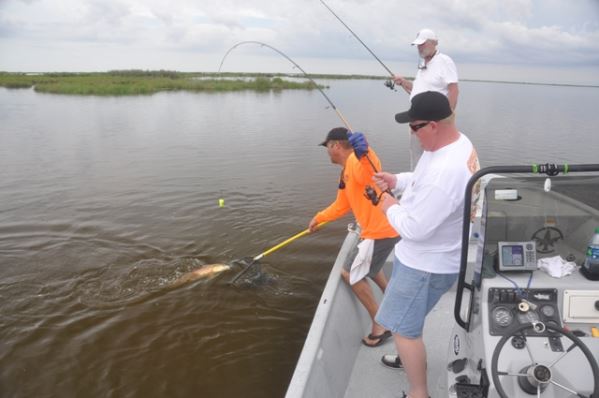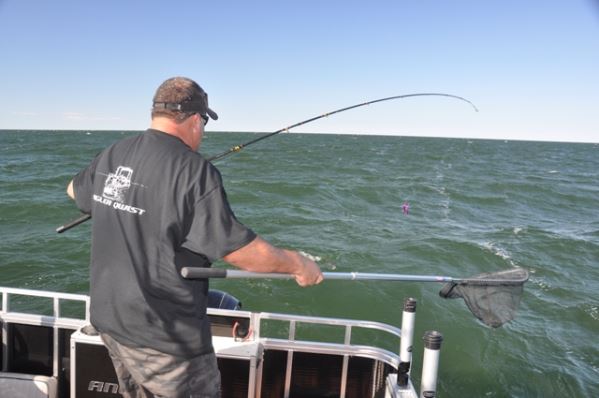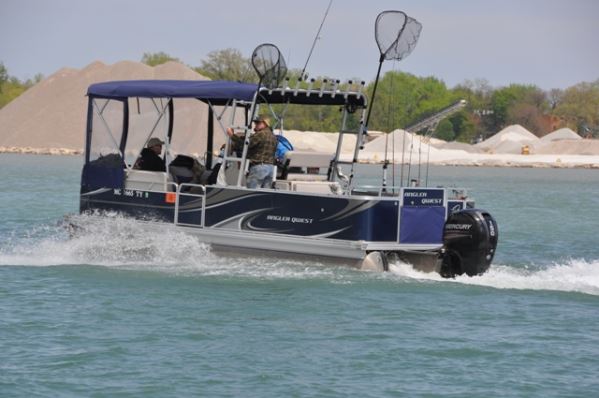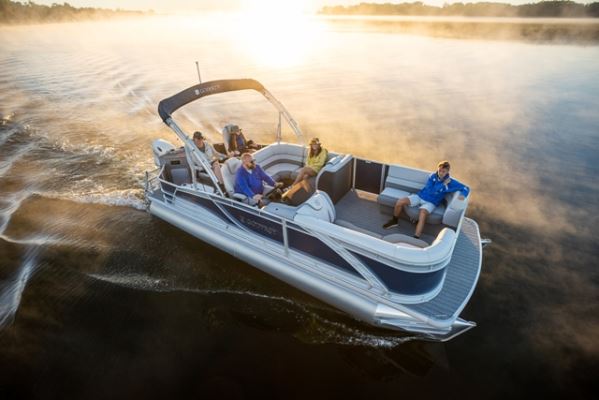 As I preach during my fishing seminars, more fish are lost right at the boat than during any other phase of a fight. That’s due to several factors, including the line tangling on gear such as props, transducers, or strakes; shearing upon contact at the boat’s sharp chine; hook angle as the fish nears the boat; less line stretch as length is reduced; angler panic and/or impatience and, most common, poor landing net technique.
As I preach during my fishing seminars, more fish are lost right at the boat than during any other phase of a fight. That’s due to several factors, including the line tangling on gear such as props, transducers, or strakes; shearing upon contact at the boat’s sharp chine; hook angle as the fish nears the boat; less line stretch as length is reduced; angler panic and/or impatience and, most common, poor landing net technique.
Compounding the fish-landing process among deck and pontoon boat owners is the high freeboard associated with our favorite watercraft, which makes reaching necessary and can add to the time the fish has to make its escape as it’s lifted from the water and hoisted over the gunwale.
Some folks figure that using a net rather than simply swinging the fish out of the water and onto the deck is a guarantee of success. Those anglers haven’t yet had a crankbait’s treble hook snag on the netting, bonked a hooked fish on the noggin with the frame, or frightened a “subdued” fish into a last-second burst of energy and freedom.
First of all, when it comes to netting fish from pontoon and deck boats, the “bigger is better” theory holds water. One thing about our favorite fishing craft: we have plenty of open deck space for storing and wielding oversized nets. And the bigger the net, the better the chance of surrounding the intended quarry in its mesh.
 Watch It Shorty
Watch It Shorty
Landing net size is determined not only by the diameter of the hoop and the depth of the mesh bag, but by the length of the handle as well. Wading anglers prefer a net with a short handle because they are often landing fish at hip level while boaters, on the other hand, often must dip their catch from water that can be two feet or more below the deck upon which they stand. In those cases, a net attached to a handle at least two feet long can come in handy. If handle length becomes a storage issue, you can find nets with shorter handles that “nest” additional sections of handle that can be telescoped to full length when needed. A good all-around net for deck boats and pontoon craft, capable of handling anything from one-pound crappie to 10-pound walleye, is one with a 3-foot long handle and a hoop diameter and mesh bag depth of 24 to 36 inches. Several manufacturers offer nets in this size range.
The most common mistake made by neophyte netters is to lunge at the fish with the net, which has several outcomes: it startles the fish into action, often when the angler least expects it, resulting in knots parting or hooks being pulled; it scares the fish away from the boat, which is the opposite direction you want it to go; and netting the fish tail-first, which is also the opposite direction you want it to go, in relation to the net.
 In The Mouth
In The Mouth
The most popular netting technique calls for the net's “mouth” or hoop and mesh to be submerged next to the boat, preferably before the unsuspecting fish is within range, with the hoop opening facing up. The fish is brought head-first over the hoop, which is raised to encase the catch. Done correctly, the fish will actually drive itself deeper into the mesh with a few sweeps of its tail. The other netting method is the jab, where the netter holds the net out of the water until the fish is within range, at which time the net is thrust under the head of the fish and scooped out of the water in one quick motion.
No matter which method you prefer, the process is the same once the fish is encased in the netting. With the fish in the mesh, the netter should point the handle straight up into the air to “close” the netting over the fish and envelope it within the mesh. The hoop and its contents are then raised over the gunwale by working up the handle hand-over-hand and swung aboard, keeping the net's handle pointed toward the heavens.
Attempting to leverage a big fish aboard using a long-handled net kept parallel to the water, rather than lifted hand-over-hand with the handle pointed to the sky, can result in a bent or broken handle as well as the risk of a lost fish – and a slipped disc for the netter!
Many anglers prefer to leave the mesh bag open and suspended beneath the hoop while waiting for the fish to be brought over the net. Their argument is that by the time the fish feels the mesh, it is already deep into the bag where its sudden struggles can be contained. Other anglers prefer to hold the bottom end of the mesh bag loosely against the net's handle (some use a sacrificial rubber band to do so) and out of the way until the fish is in the hoop. This method, they contend, keeps the mesh from getting tangled in the hooks before the fish is inside the net.
 Dan’s Pick
Dan’s Pick
Godfrey Monaco MC235 FS
As a nod to the popularity of fishing from pontoon boats, Godfrey Marine has added two new angling-specific additions to its luxury line of Monaco Pontoons, the MC235 FS and the MC255 F. Both models are equipped with a dedicated fishing station with a livewell that can double as a day cooler, cupholders that double as rod holders, dedicated upright rod holders, knife and tool storage, and stern fish seats on removable pedestals.
Available in 23- and 25-foot lengths, with an 8-foot, 6-inch beam, Monaco FS packages are offered with standard 27-inch tubes or a choice of 27- or 29-inch sport tubes, as well as an optional 27- or 29-inch center tube. Based on configuration, the MC235 FS and MC255 FS can accommodate between 12 to 16 and 14 to 17 passengers and be powered with 150hp to 300hp and 150hp to 400hp, respectively. While that sounds like overkill and quite a crowd for a fishing craft, there’s nothing saying you can’t be more conservative with both when wetting a line! And you can’t beat the luxury.
Length: 23’ 11”
Beam: 8’ 6”
Weight: 2,506 lbs.
Passenger Capacity: 16
Fuel Capacity: 30 gals.
Max Power: 150hp
www.godfreypontoonboats.com

